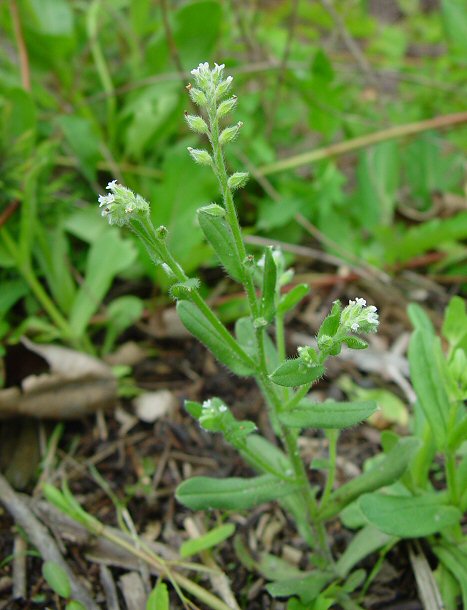Myosotis macrosperma Engelm.
Big-Seeded Scorpiongrass

Native
CC = 3
CW = 0
MOC = 21
© DETenaglia
Myosotis macrosperma Engelm.Big-Seeded Scorpiongrass | |
 |
Native CC = 3 CW = 0 MOC = 21 |
© DETenaglia |
|
Family - Boraginaceae Habit - Taprooted annual forb. Stems - Ascending to erect, to 60 cm, occasionally multiple from the base, slightly angled from decurrent leaf tissue, usually unbranched below the inflorescence, moderately to densely pubescent with fine, loosely ascending to spreading, usually minutely pustular-based hairs, these not hooked at the tip.
Leaves - Alternate and usually basal, simple, entire. Leaf blades 2-8 cm long, 6-16 mm wide, lanceolate to narrowly oblong-elliptic or oblanceolate, rounded or angled to a bluntly or sharply pointed tip, with a single distinct midrib, the surfaces and margins densely pubescent with fine, loosely ascending to spreading, minutely pustular-based hairs, these not hooked at the tip.
Inflorescence - Terminal and lateral scorpioid racemes or cymes, compact in flower, very elongated in fruit. Flower stalks 0.5-2.0 mm long at flowering, elongating to 2-4 mm at fruiting and loosely ascending (angled away from the axis) at fruiting with a noticeable bend or curve at the tip, the inflorescence with linear to narrowly oblong, leaflike bracts at the branch points and lowermost flowers. Axis of inflorescence hairy.
Flowers - Calyces 1.5-2.5 mm long at flowering, elongating to 5-8 mm at fruiting, slightly zygomorphic at flowering but becoming nearly 2-lipped at fruiting, 5-lobed slightly about 1/2 of the way to the base, the 3 upper lobes shorter than the 2 lower lobes, especially at fruiting, triangular to narrowly triangular, densely pubescent with spreading, stiff hairs that are hooked at the tip. Corollas 2-3 mm long, 5-lobed, white, funnelform, glabrous, slightly zygomorphic, the tube 1.4-2.0 mm long, the spreading portion 1-2 mm in diameter. Fornices small, included in the throat of the corolla. Stamens 5, inserted below the midpoint of the corolla tube. Ovary 4-lobed, subtended by a green nectary. Style exserted from between ovary lobes, green, 0.2-0.3 mm long, glabrous, included. Stigma bilobed.
Fruits - Nutlets 1.5-2.2 mm long, greenish brown to dark brown.
Flowering - April - June. Habitat - Prairies, bases and ledges of bluffs, swamps, forests, pastures, fields, railroads, roadsides, and open, disturbed areas. Origin - Native to the U.S. Lookalikes - M. verna. Other info. - This species is widely scattered in Missouri, relatively uncommon except near the Bootheel. Within the continental U.S. its distribution is mostly southeastern, although it is found as far north as Pennsylvania. The plant is characterized by its small white flowers with calyces having hooked hairs. It is easily confused with its lookalike, M. verna, and indeed has been considered a variety of that species. Differentiation is usually based upon M. macrosperma having hooked hairs (rather than straight) on the base of the calyx and fruit stalks which diverge from the stem (rather than being stiffly erect). The fruits are also usually farther apart along the axis (>10 mm, vs. <10 mm in M. verna). However, the two plants are very similar and some specimens can be difficult to assign. Photographs taken off Hwy 29, Guilford County, MO., 4-20-03 (DETenaglia); also at Rockwoods Range Conservation Area, St. Louis County, MO, 4-29-2011, and Glassberg Conservation Area, Jefferson County, MO, 4-30-2020 (SRTurner). |